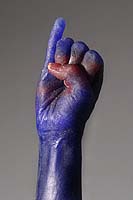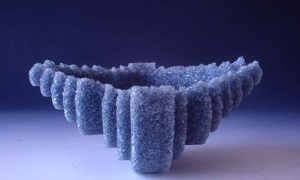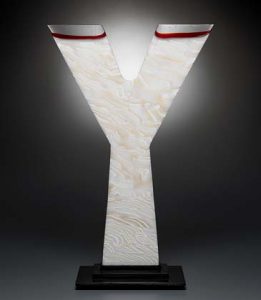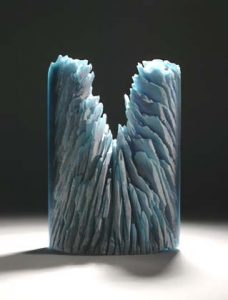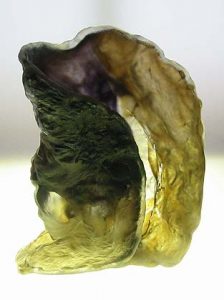Glass Art Technique
Blown Glass, Cast Glass, Fusing & Slumping
by Alison Ruzsa & Sami Harawi
Glass is an art medium with seemingly endless technical versatility and a rich, long history. Basic elements of sand and soda lime are combined with coloring agents, then melted together to produce the raw material. The raw (soft) glass prepared in Murano, Italy, has a great reputation anchored in centuries of appreciation for its high quality. Although this well deserved reputation persists today, good quality glass is produced elsewhere, particularly in the United States
(Corning, Bull’s Eye and Schott glass).
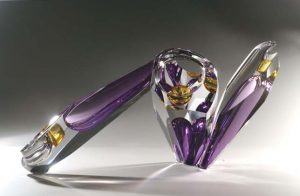 This essay will attempt to clarify technical glass jargon and to describe in simple terms the commonly used glass art techniques. Most of those are illustrated in the sculpted letters created by the artists participating in The ABC of Glass Art. References to images of their work are throughout the text.
This essay will attempt to clarify technical glass jargon and to describe in simple terms the commonly used glass art techniques. Most of those are illustrated in the sculpted letters created by the artists participating in The ABC of Glass Art. References to images of their work are throughout the text.
No one knows exactly where and when experimenting with Blown Glass, began. The earliest examples are circa 100 BC. The technique spread rapidly across the Roman Empire early in the Common Era. Although glass blowing has reached a high level of sophistication, very little of the technique itself has changed since the early times. To create a blown glass object, the molten glass is gathered from the furnace on the end of a long hollow metal tube, the blowpipe. At this stage the glass is typically around 2100 degrees (Fahrenheit), and has the consistency of honey (it becomes very stiff at around 900 degrees). The glassblower puffs air through the blowpipe into the center of the gather.
A variety of tools are then used to shape the glass to form. As the glass cools it begins to stiffen and must be reheated to allow shaping and reshaping. For these re-heats, the glassblower uses a smaller furnace, the glory hole (because of its bright glow). The re-heats allow the artist to work on a piece for a long time, shaping and blowing until the desired result is achieved. When the piece is finished, it is placed in an oven, the Kiln for annealing.
Annealing is the process of slowly cooling the glass to room temperature to stabilize its delicate crystalline structure. The piece will crack if heated or cooled too quickly. Annealing is not only for blown glass, it is an integral part of most of the techniques described below. Hot Sculpting denotes a technique in which glass is gathered from the furnace on the end of a solid metal rod called a Puntil, or Punty, and shaped into a sculpture (Petro). Incalmo in Italian means graft. It is a process which involves blowing at least two separate cylinders of glass and joining them together (grafting them) at the open end to create a Vessel or a sculpture composed of pieces with different colors and or content.
Cast Glass predates blown glass. The first casting technique, core-formed, is as old as glass itself. It dates back to 2500 BC when bead work started in Mesopotamian and was followed by small core-formed vessels. Scholars believe that glass was originally a by product of fine silver smelting and this by product was used first as a ceramic glaze. Core-formed Glass technique consists in applying heated glass rods and murrine to the outer part of a mold (Matsushima). Today a wide range of techniques are used to cast glass. Pate de Verre (French for paste of glass) and Kiln Casting are similar. Both involve filling a mold with glass particles, then heating it in a kiln till the glass fuses together at the melting point. In Pate de Verre (del Maestro’ cast hand, i below) the glass is crushed into a fine paste before it is put in the mold. For Kiln Casting (King’s Y, below), chunks of glass are used. Carl van Hees has used specially prepared granulated glass (C below).
In Hot Casting (Zimmermann, below right), glass is heated at a temperature higher than for blowing glass (around 2350 degrees Fahrenheit). It is scooped out of the furnace with large ladles and poured into a mold. Usually, the molds are made of ceramic and silica, materials that withstand very high temperatures. Lost Wax is a method similar to bronze casting (Barney and O’Dorisio). The positive is carved from a wax block. A plaster mold is then built around it. The wax is melted out and the mold refilled with molten glass then fired in the kiln. Subtraction casting consists of carving out a shape from a solid cast glass block (like carving a stone). This technique is carried to a very interesting level by Alex Bernstein. The color in Alex’s abstract sculptures comes from the glass itself (below left), or from applying metal dust that results in a rusted look. Sand Casting is an ancient technique. It involves creating a mold by depressing objects into silica sand (which is mixed with a binder and / or injected with C02 to make it hard). Molten glass is poured into the mold. Optic Glass (Janacek, below center) is the glass that is cut in geometric forms then polished. It can start as blocks of glass (from a company like Schott glass), or cast by the artist, then polished.
Slumping & Fusing are techniques that use flat pieces of (usually colored) glass (similar to the glass used by stained glass artists), manufactured with specific coefficients of expansion to make them compatible for melting together. In Fusing, multiple pieces are arranged in a pattern and heated in a kiln (Krage). In Slumping, the glass is laid into, or on top of a mold and heated just to the point where it “slumps” or moves with gravity when it becomes fluid with the heat, to fit the form of the mold (Kanda). Once the glass reaches the desired form it is cooled quickly enough to stop the movement but slow enough not to destroy the crystalline structure (del Maestro and Heyd). Although these methods sound simple, the objects created often have intricate designs. Hours of painstaking labor may go into the arrangement of the glass. Many of these pieces require multiple firings in the oven to achieve the desired results.

